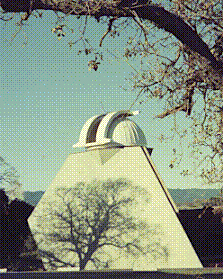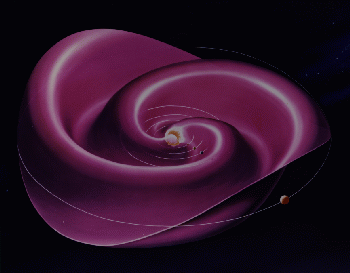 The Wilcox Solar Observatory
The Wilcox Solar Observatory

The Wilcox Solar Observatory (WSO) began collecting daily observations of the
Sun's
global (or mean) magnetic field in May 1975
(Scherrer+1977),
with the goal of understanding changes in the
Sun
and how those changes affect the Earth. That science is called
space weather.
Since May 1976 daily low-resolution maps of the Sun's magnetic field have been made at WSO,
along with observations of solar surface motions.
The observatory is located in the foothills just south of the
Stanford University main campus.
Current WSO research topics include
space weather,
the large-scale magnetic field, and
the solar cycle.
The observatory and staff are also associated with the Helioseismic and Magnetic Imager
(HMI) project on the
Solar Dynamics Observatory (SDO) and the
COFFIES DRIVE Science Center.
HMI provides continuous real-time high-resolution
solar observations of the velocity, intensity, and magnetic field from geosynchronous Earth orbit.
The Solar Observatories Group previously operated the
Solar Oscillations Investigation
that uses the Michelson Doppler Imager (MDI) instrument on the
SOHO spacecraft
to observe the inside of the
Sun.
More information is available concerning
the Solar Observatories Group,
the Hansen Experimental Physics Laboratory (HEPL),
the Kavli Institute for Particle Astrophysics and Cosmology (KIPAC),
and about the
Experimental and Observational Astrophysics and Cosmology
and
Theoretical Astrophysics and Cosmology programs in the Stanford University
Physics Department.
Stanford University operates WSO with funding provided by the National Science Foundation with Grant #1836370.
NASA funding for WSO ended in 2018. Historically WSO has been supported by
NASA Heliophysics,
the NSF,
and the Office of Naval Research.
Prof. J. Todd Hoeksema serves as WSO director.
 Pictures of WSO, staff members and other local wildlife.
Pictures of WSO, staff members and other local wildlife.
** ** ** Announcements ** ** **
Due to Flooding in the Stanford JSOC Computer Facility on 26 November 2024,
we cannot process new WSO data. Observations are being made.
We expect to restore access to new data in January 2025.
See
JSOC Emergency Resources for updates
The Sun's polar field direction has reversed for Cycle 25.
The south in mid 2023 and the north in late 2023. The smoothed average in August 2023.
Local weather prevented continuous observations in winter 2023/2024.
WSO Solar Magnetic Field Observations
Magnetograms
sn=16490 time=2025:01:28_22h:07m:47s CT2293:069
trouble=40000000 sky= 1 NOTE:
24 do not use for anything!
|

|
Most recent WSO Magnetogram
|
|
[.gif] |
[.ps]
|
Daily Magnetogram Atlases
-
Contour: GIF, PS, & PDF:
DAILY magnetograms plots available from 1994 onward showing B as well as Velocity and Intensity (updated
monthly)
-
Contour Postscript and gif
Daily photospheric magnetic field: 1995-present (updated daily). This year:
2024:
Jan,
Feb,
Mar,
Apr,
May,
Jun,
Jul,
Aug,
Sep,
Oct,
Nov,
Dec
2023:
Jan,
Feb,
Mar,
Apr,
May,
Jun,
Jul,
Aug,
Sep,
Oct,
Nov,
Dec
2022:
Jan,
Feb,
Mar,
Apr,
May,
Jun,
Jul,
Aug,
Sep,
Oct,
Nov,
Dec
2021:
Jan,
Feb,
Mar,
Apr,
May,
Jun,
Jul,
Aug,
Sep,
Oct,
Nov,
Dec
2020:
Jan,
Feb,
Mar,
Apr,
May,
Jun,
Jul,
Aug,
Sep,
Oct,
Nov,
Dec
2019:
Jan,
Feb,
Mar,
Apr,
May,
Jun,
Jul,
Aug,
Sep,
Oct,
Nov,
Dec
-
Colorized GIF:
An atlas of magnetograms in gif format since 1988.
Synoptic Charts of the Photospheric Magnetic Field
- An ATLAS [GIFs, PS plots + Tables]
of photospheric field synoptic charts for
Carrington Rotations since May 1976 or
- A preliminary plot of the most recent 360 degrees:
[gif]
[ps] of data.
[pdf] of data.
Computed Coronal Field Maps
- An ATLAS
[GIFs & PS plots + Tables] of computed coronal field synoptic charts
since May 1976 or
- Our most recent preliminary classic
360 degrees
[ps]
line-of-sight computation.
- Our most recent preliminary radial Rs=2.5:
360 degrees
[ps] computations.
- Our most recent preliminary radial 3.25 Rs:
360 degree
[ps] calculations.
Numerical Data Tables
Data request forms for
Computed Coronal Magnetic Field Tables
Radial Boundary Condition
Classic Line-of-Sight Photospheric Boundary Condition Rs=2.50 with standard polar field correction
The Mean Magnetic Field of the Sun
Warning: WSO Polarization Sensitivity was reduced from 16 December 2016 to 18 May 2017.
Mean field values have NOT been recalibrated and are a factor of about 1.55 too small during that interval.
 Other Quantities
Other Quantities
The computed tilt angle
[Table]
[.gif]
[.ps]
of the
Heliospheric Current Sheet is related to the measured
Solar Polar Field Strength:
table |
[.gif] |
[.ps] |||
North [.gif] |
South [.gif]
Since 2010:
[.gif] |
[.ps] ||
North: [.gif] |
[.ps] ||
South: [.gif] |
[.ps] |
References
Zonal magnetic flux transport over nearly 5 solar cycles:
Net+Total: [.gif]
Symmetric and Antisymmetric Components: [.gif]
Solar Dipole and Multipole Components
Sector Boundary Lists
Calibration NOTES:
2017: Warning: WSO Polarization Sensitivity was reduced from 16 December 2016 to 18 May 2017
due to contamination on the Littrow lens.
Magnetograms and derivative products (including polar field) were recalibrated (as of 21 March 2018)
by a factor of 1.55.
Note that Meanfield values have not been recalibrated.
2000: WSO sensitivity problems from CR 1970 - CR 1992 (November 2000 - July 2002)
have been quantified and the data have been recalibrated.
Contact us if you detect any anomalies.
Note that Meanfield values have not been recalibrated.
Related Items of Interest.
WTRs - WSO Task Reports
WTRs - WSO Technical Info
Schematics - WSO Technical Info
The WSO Web Page Format and data analysis processing were updated in late 2006.
Contents do not necessarily reflect the views of the NSF.
Please send comments to
Todd Hoeksema
 The Wilcox Solar Observatory
The Wilcox Solar Observatory
 The Wilcox Solar Observatory
The Wilcox Solar Observatory

 Pictures of WSO, staff members and other local wildlife.
Pictures of WSO, staff members and other local wildlife.


 Other Quantities
Other Quantities